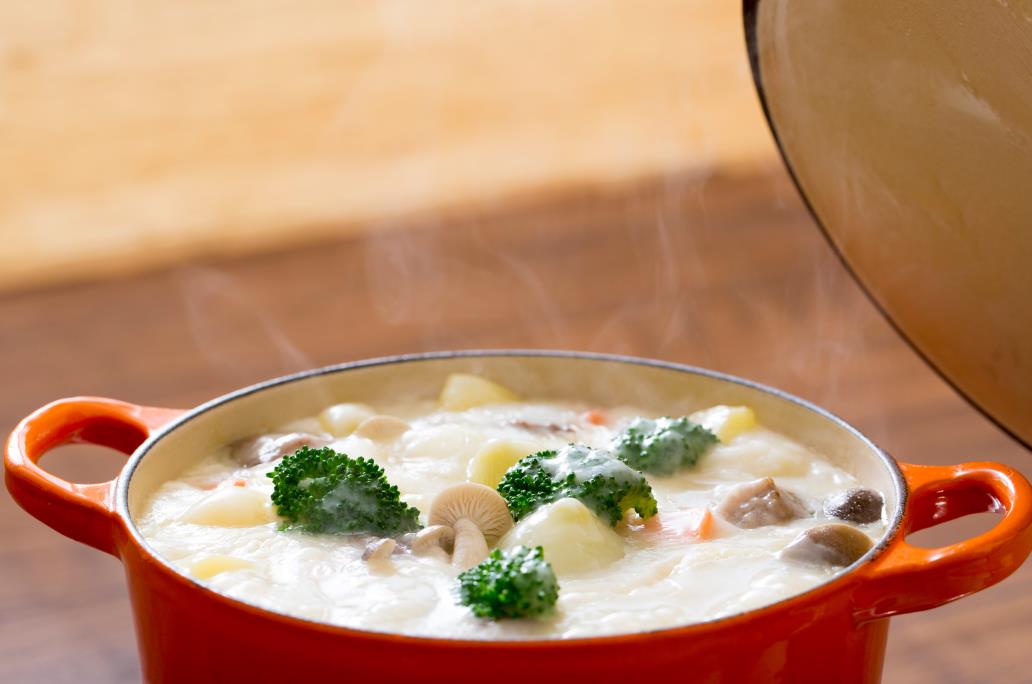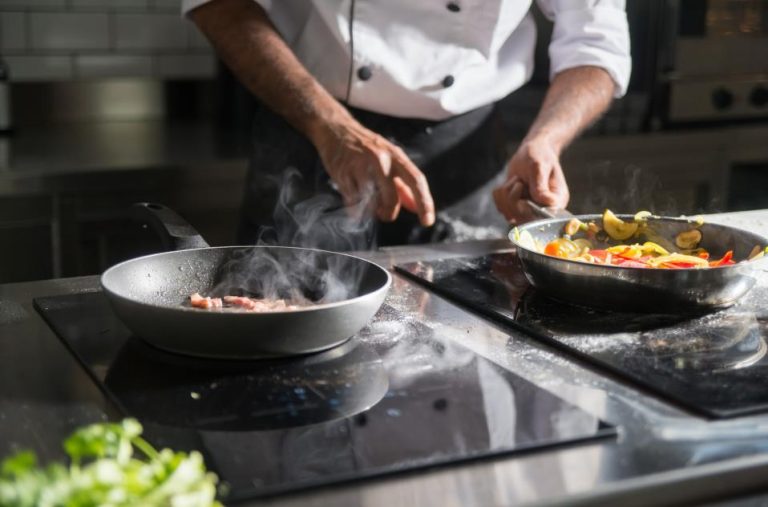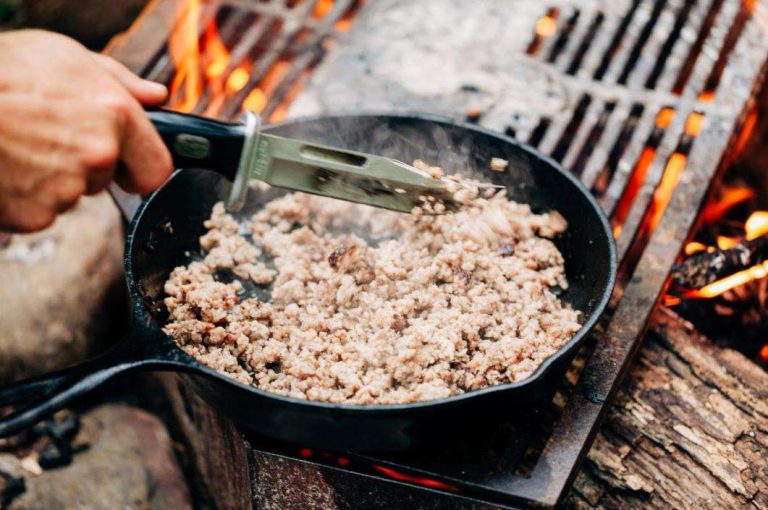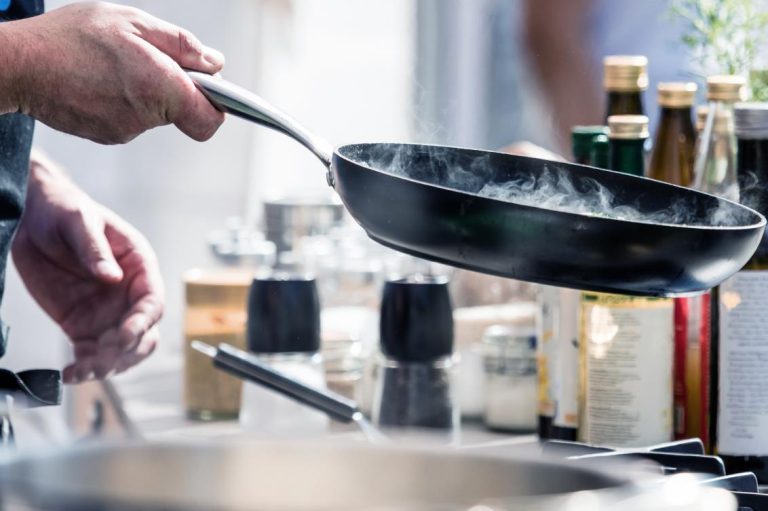Owing to their glossy cooking surface, enameled cast iron is considered a more convenient version of plain cast iron cookware. They are non-stick, easy to clean, and require little to no maintenance whatsoever.
While having a non-stick cooking surface, shoppers may question the safety of enameled cast iron cookware. After all, the relationship between a non-stick cooking surface and safety has long been scrutinized.
It is apparent that using enameled cast iron cookware for daily use is completely safe. The question is how safe it is, and what risks your customers should look out for. In this article, we’ll assess the safety of enameled cast iron cookware in detail to give you the whole picture, but before that – let’s learn what sets enameled cast iron and bare cast iron apart.
How is enameled cast iron different from traditional cast iron?
Cast iron cookware is popular among many cooks. It doesn’t stick – provided with seasoning. A seasoned cast iron skillet provides its naturally non-stick surface without relying on chemicals.
Although a seasoned cast iron skillet won’t stick, the cooking surface is reactive. Adding acidic foods to the recipes will make the iron react, where the food may stick due to stripped seasoning. Cooking acidic foods for a short duration won’t damage the seasoning, but it’s best to avoid them.
Enameled cast iron eliminates these worries with its vitreous coating. The coating is powdered glass fused at high temperatures to cast iron. It seals the iron all while holding to its heat retention capabilities favored by cooks.
Not only the enamel coating is non-reactive, but it also holds non-stick attributes. However, tossing something on a dry enameled cast iron pan will stick and lead to staining. For enameled cast iron to be non-stick, it needs a touch of cooking oil.
Overall, enameled cast iron provides a partially non-stick coating that’s easier to clean and maintain. There is more to enameled cast iron and cast iron, but these are the primary differences.
Is enameled cast iron safe?

The non-stick cooking surface of enameled cast iron raises some concerns about its safety. This is often something that cooks moving from traditional cast iron skillets and pots to enameled cast iron questions. Rest assured, enameled cast iron cookware, whether a pan or a Dutch, is completely safe.
The partially non-stick enamel cooking surface doesn’t emit harmful chemicals, unlike many Teflon-coated pans and pots. Even when the cookware is heated to high temperatures, it remains non-toxic.
Since enameled cast iron is non-reactive, the cooking surface doesn’t mind a splash of vinegar or tomato sauce. This enables cooks more freedom in what they can add to their recipes. The enamel seals the iron completely, preventing metals from reacting and leaching into foods.
At the same time, the enamel-coating ensures the cookware doesn’t get rusted as the iron can’t react with the environment. Although ingesting tiny amounts of iron from foods cooked with cast iron won’t cause harm, the enamel coating completely blocks the metal from touching the food.
Despite not releasing harmful chemicals, cooks should be careful with heating enameled cast iron. Overheating can damage the enamel coating if it goes on for too long. It’s best to use enameled cast iron cookware over medium-high temperature at maximum, though cooks can get away with searing steak occasionally.
All these make enameled cast iron a non-toxic, totally safe cookware material. Yet, cooks should take some precautions while working with an enameled cast iron.
Buy Wholesale Cookware and Start Scaling up with Us Today
Contact us and connect with a sales rep to get a free quote.
Ensuring the safety of enameled cast iron cookware
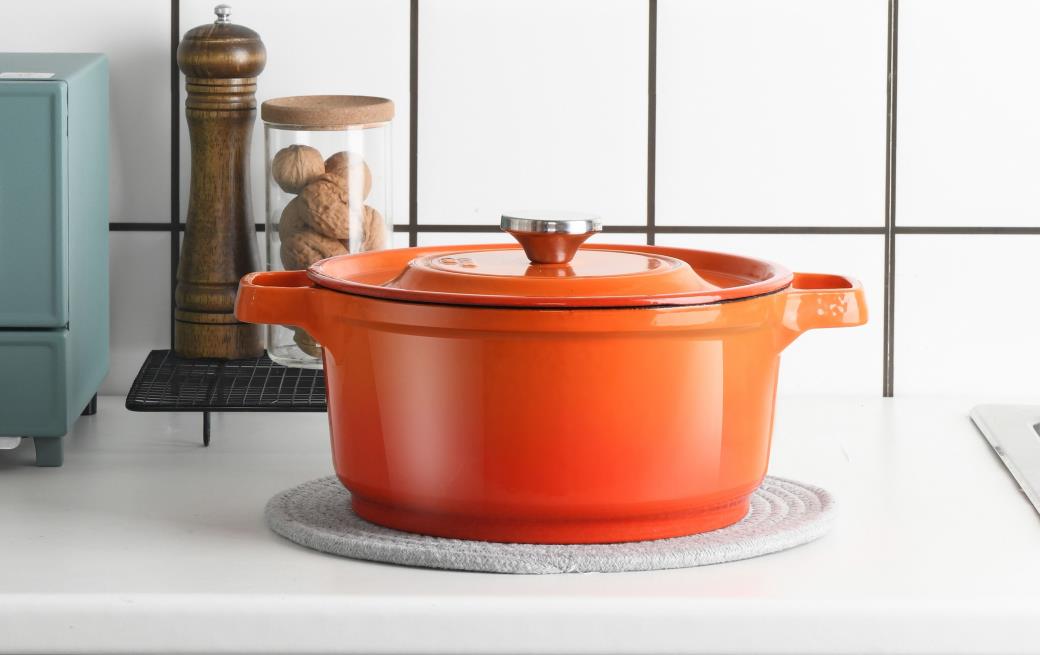
Enameled cast iron cookware has a non-reactive, non-stick cooking surface, but the coating is quite flimsy. Using a Le Creuset Dutch oven like a stainless steel pan can damage the surface. If this happens, the iron will be exposed, which raises safety concerns.
Since there is no way to ‘season’ exposed iron, it can contaminate the food and lead to health problems. For this reason, there are some dos and don’ts with enameled cast iron cookware. Here are a few tips to ensure this type of cookware doesn’t become damaged, and ultimately, unsafe.
- When stirring or flipping foods, metal or hardy utensils should be avoided. These can scratch and chip the surface, which requires repairing – or worse, a new piece of cookware. Silicone and wooden utensils are the best pairs for enameled cast iron.
- Enameled cast iron cookware shouldn’t be heated empty. While it resists high temperatures fairly well, heating enameled cast iron without oil or water can lead to cracks. These should cover the surface area before turning on the heat.
- Like metal utensils, abrasive cleaners can damage the enamel coating. Advise customers to leave enameled cast iron cookware to soak to remove stubborn stains.
- Enameled cast iron has low thermal shock resistance. If plunged into cold water when it’s hot, it can crack the surface. Cooks should wait for the cookware to cool before soaking.
Paying attention to these and incorporating the right enameled cast iron care routine ensures the cookware is safe and cooks well. By doing so, enameled cast iron will be an overall pleasure to cook with, especially for slow cooking.
So is there a health risk with enameled cast iron?
Any quality enameled cast iron is safe. As a cookware material, enameled cast iron is non-reactive and non-toxic. It is entirely safe whether cooks use enameled cast iron cookware to prepare stews, stir-fry, sear steak, or sautee.
The only occasion where it can be unsafe is due to a chipped surface. That’s why enameled cast iron requires a gentler way of using it. These can be demanding to cooks using enameled cast iron for the first time. Still, most cooks know it’s worth the safe cooking surface that’s non-stick and low maintenance.
Enameled cast iron pros and cons
Pros
- Non-reactive and non-stick: The enamel coating seals the iron, making it a non-reactive cooking surface while equipping it with non-stick abilities.
- Low maintenance: Enameled cast iron cookware requires minimal care. It’s easy to clean, often without the need for soaking or aggressive scrubbing.
- Durable: Even with regular use, enameled cast iron cookware lasts years.
- Entirely safe: Enameled cast iron prevents iron from leaching iron into food. The coating doesn’t emit harmful chemicals, even at high temperatures.
- Attractive appearance: Enameled cast iron Dutch ovens, pans, pots, and others come in various colors that fit the aesthetics of every kitchen.
Cons
- Fragile surface: While the coating is efficient in cooking, it is delicate. Cooks must avoid metal utensils and store individual pieces of cookware separately.
- Slow to heat: Although it holds heat efficiently, enameled cast iron takes time to heat. It isn’t the best cookware to use for midnight snacks.
- Heavy: There is a good amount of weight to enameled cast iron cookware. It weighs a lot more than other types of cookware.
- Prone to staining: The enamel surface tends to hold stains. The light-colored enamel surfaces are susceptible to discoloration from foods and liquids. These also happen due to high-heat cooking.
Enameled cast iron vs. ceramic cookware

Ceramic cookware comes in two types: clay-based and ceramic-coated. Clay-based, 100% ceramic cookware is rare. The ceramic-coated cookware is more prevalent in the market. This cookware is often viewed and marketed as a safer alternative to PTFE-coated non-stick pans and pots.
Enameled cast iron and ceramic cookware are very different from one another. While the core features, such as a non-reactive cooking surface that doesn’t stick and low maintenance needs, are the same, they provide different cooking experiences.
Enameled cast iron takes high heat better and has much superior heat retention. Ceramic-coated cookware, with its aluminum or steel base, conducts heat better but can’t hold it as well. These distinctions change how cooks utilize pots and pans to make different dishes.
Despite their differences, ceramic cookware is a great alternative to enameled cast iron. Cooks who dislike the bulky nature of enameled cast iron usually go for ceramic cookware. Plus, they look similar, with various colors.
Buy Wholesale Cookware and Start Scaling up with Us Today
Contact us and connect with a sales rep to get a free quote.
Should you sell enameled cast iron cookware in your store?
Among the various cookware materials, enameled cast iron is a big favorite. Cooks appreciate how well it holds heat – all topped with its convenient cooking surface. It’s suitable for a range of cooking styles and works on various heat sources, including induction stovetops.
These features alone make enameled cast iron cookware appeal to a diverse range of cooks, from those at home to professional chefs. Selling enameled cast iron cookware is a worthwhile investment to shops of all sizes. It’s an attractive product that appeals to a diverse customer base.
If you’re on the hunt for wholesale enameled cast iron cookware, we can help you find suppliers. LeeKnives doesn’t manufacture cookware – what we can do is connect you with the leading manufacturers in China. Let us assist you in finding suppliers, so you can focus on ways to bring sales.
Sourcing cookware from us follows the same seamless process as with our knives. Get in touch with us to request a quote.
